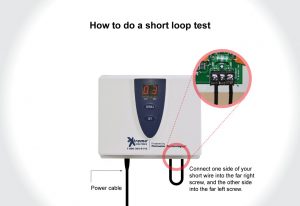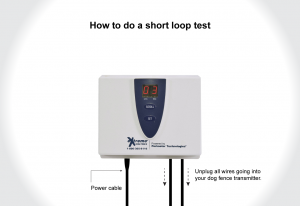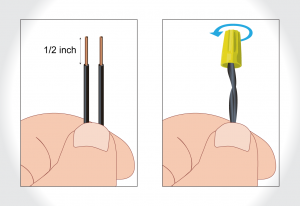How To Find Break In Underground Dog Fence
Finding a Suspension
Finding and Fixing a Wire Break
Over the lifetime of an electrical dog fence, it is non uncommon for a wire break to occur. If a wire should break, your transmitter box will permit you know by endlessly beeping and flashing. You may also notice that your receiver collars are no longer reacting when you approach the wire.
Performing a Short Loop Examination
Your dog argue transmitter will let you know at that place is a break in the line by setting off an alarm. If your transmitter is alarming, and yous call up you may accept a wire break, the start thing to bank check is the functionality of your dog argue transmitter. The concept of a short loop test is to create a tiny little loop of dog fence wire on your transmitter, to encounter if your transmitter is still alarming when this short loop of wire is connected.
Here is how to do a short loop exam:
- Unplug all wires going into your dog argue transmitter.
- Cut a small piece of wire (12 inches) and strip both ends of it.
- Connect each end to your two terminals going into your domestic dog fence transmitter, creating a tiny picayune loop.
- Plug in your dog fence transmitter.



Is your transmitter still beeping? This means that there is a trouble with your dog debate transmitter. Please contact us at 800-305-6116 to meet if your transmitter is covered under warranty. Did your transmitter cease beeping with the brusk loop hooked up to it? This means that there is likely a problem in your dog fence wire. If the audible alarm stops when you are testing using a short loop, you can test your collar using the short loop, if y'all like.
Place your dog contend collar next to the short loop, making certain that the range is fix low plenty on the transmitter. Hold your receiver collars a few inches abroad from the loop, and make sure you have fresh batteries inserted in the collar. Your dog fence collar should beep when you place information technology next to the wire.
Testing Wire Continuity with a Multi-Meter
A multi-meter tin can also be used to verify the main loop functionality. A multi-meter can be purchased from whatever hardware or habitation comeback store.
Begin by setting the multi-meter to the continuity setting, which is the position that resembles a speaker. Next, touch the tips of the metal legs to the ends of your twisted wire. Next, listen for your multi-meter to beep. If it does, that means y'all take continuity in your domestic dog fence wire. This means that your loop is functional and that you don't have a wire suspension. If you don't have a wire intermission, the problem could exist in your collar or transmitter.
Ways to Detect a Wire Pause
Wire Break Locator Kit
You tin locate a wire intermission, by using a Wire Interruption Locator Kit. It includes a mini transmitter and an AM radio.
Based on our extensive testing, information technology has been adamant that this device only works well for fence systems with less than 500 feet of domestic dog fence wire. In add-on to this, the breaks must be clean, equally opposed to partial or decaying breaks.


What to exercise:
- Unplug your canis familiaris fence transmitter.
- Connect your wire interruption locator to your twisted wire.
- Ground the sending unit by attaching the enclosed wire to the eye screw of an electrical outlet.
- Plug in the sending unit, and so that both lights on the transmitter are lit.
- Turn on the AM radio, turning the station to 530 KHZ. Y'all might need to suit the dial to a channel that doesn't have a radio station.
- Begin to follow the twisted wire with the radio towards the main dog fence loop. Y'all volition brainstorm to hear a combination of two sounds equally y'all follow the twisted wire. Should in that location be a break in the twisted wire, the sound will slowly switch from two sounds to one audio.
- If everything from the twisted wire checks out fine, begin to follow the principal dog contend loop. You lot will begin to hear one steady sound. Follow the dog fence wire until this tone gets softer or begins to change. Begin to dig effectually this area and locate both ends of where your wire has cleaved.
- Should yous run into interference bug, disconnect your twisted wire from the main loop and connect both ends of the primary loop to your sending unit. Y'all will have to run an extension cord to your primary loop in order to power it upwards.
Visual Inspection


The following things commonly cause wire breaks: edgers, weed whackers, lawn aerators and rodents. Physically doing a walk around your perimeter looking for indications of any of these situations happening is the first way to look for a wire intermission.
The second place to check would be where your splices or wire connectors are located. Sometimes this is the area where the wires tin become pulled apart inadvertently.
- Start at the transmitter. Inspect the wire from the exit point through the door, wall or window. Carefully inspect where the twisted wire leaves your home. This is a common area where the wire can be cleaved. Examine the ground where the twisted wire is placed, looking for possible areas of disturbance.
- Walk effectually the perimeter looking for whatever disturbances in the ground. Pay specific attention to the driveway, pathway, sidewalk and areas where there is heavy foot traffic. These areas are the most common places where wire breaks can exist constitute. Look carefully at edge lines at driveways and sidewalks.
RF Choke Method
You can also use the RF choke method to detect a wire interruption. First, you lot volition demand to purchase an RF choke at your local electronics supply or hardware shop. Next, disconnect your wires from your transmitter and supercede them with the choke-one end of the choke in each lead on the control box. Adjacent, turn the betoken strength all of the fashion up. In that location should not exist whatever wire interruption error when the choke is in place. Now, have your two end wires and attach one to either side of the choke by wrapping the wire effectually the asphyxiate. Be sure that the choke is touching the uninsulated end of each wire. Employ the AM radio to detect the break past walking the perimeter and listening for silence. There should be audible pulsing where the wire is intact, and silence where the break is located.
To Partially Supplant Domestic dog Fence Wire:
If your domestic dog fence wire is old, consider replacing information technology before investing too much time locating and repairing a suspension in your wire. Canis familiaris fence wire is relatively inexpensive, and installing it is easier to exercise the 2d time around. You may decide to skip the pathways and driveways. Instead, you can splice into them on both ends, although it is a good thought to examination areas as you replace each department of wire.
- To brainstorm, locate the ends of twisted wire that are coming into contact with the principal loop of your electrical dog fence.
- Disconnect your twisted wire from your main loop. Strip about ½ inch of wire from the twisted wire so that you tin run into the copper. Twist both ends of the wire together, temporarily.
- Go over to your domestic dog fence transmitter and examination for continuity with a meter. If your twisted wire is skilful, motion on to your next step. If information technology isn't, replace your twisted wire, or locate where your break is in your twisted wire. If your twisted wire was broken and you repaired or replaced it, temporarily connect the twisted wire ack to the main loop. Go to your dog debate transmitter box and test for continuity. If your main dog fence perimeter tests well, permanently repair or replace just the twisted wire. At that place isn't a need to await further. If you even so don't have a complete loop, go on to the adjacent step.
- If you have figured out that the intermission is not in the twisted wire, begin to partially supersede areas of your wire that are questionable. After y'all have replaced certain sections of your wire, go back to your transmitter to meet if the problem has been corrected. Yous tin also run a piece of standard wire from each end of your twisted wire to the center of your fence and connect them to your loop. This makes it easier for the break to be isolated, allowing the search area to be lessened for potential breaks.


Repairing a Break
Once you have found the wire interruption, strip off a ½ inch of insulation on each side and and then use a waterproof splice capsule or waterproof wire nut to put the two ends together again. Should the wire exist too short to rejoin the two ends, you can just splice in another section of wire to create the connection.
Source: https://www.extremedogfence.com/finding-a-break/
Posted by: coatesperis1986.blogspot.com


0 Response to "How To Find Break In Underground Dog Fence"
Post a Comment